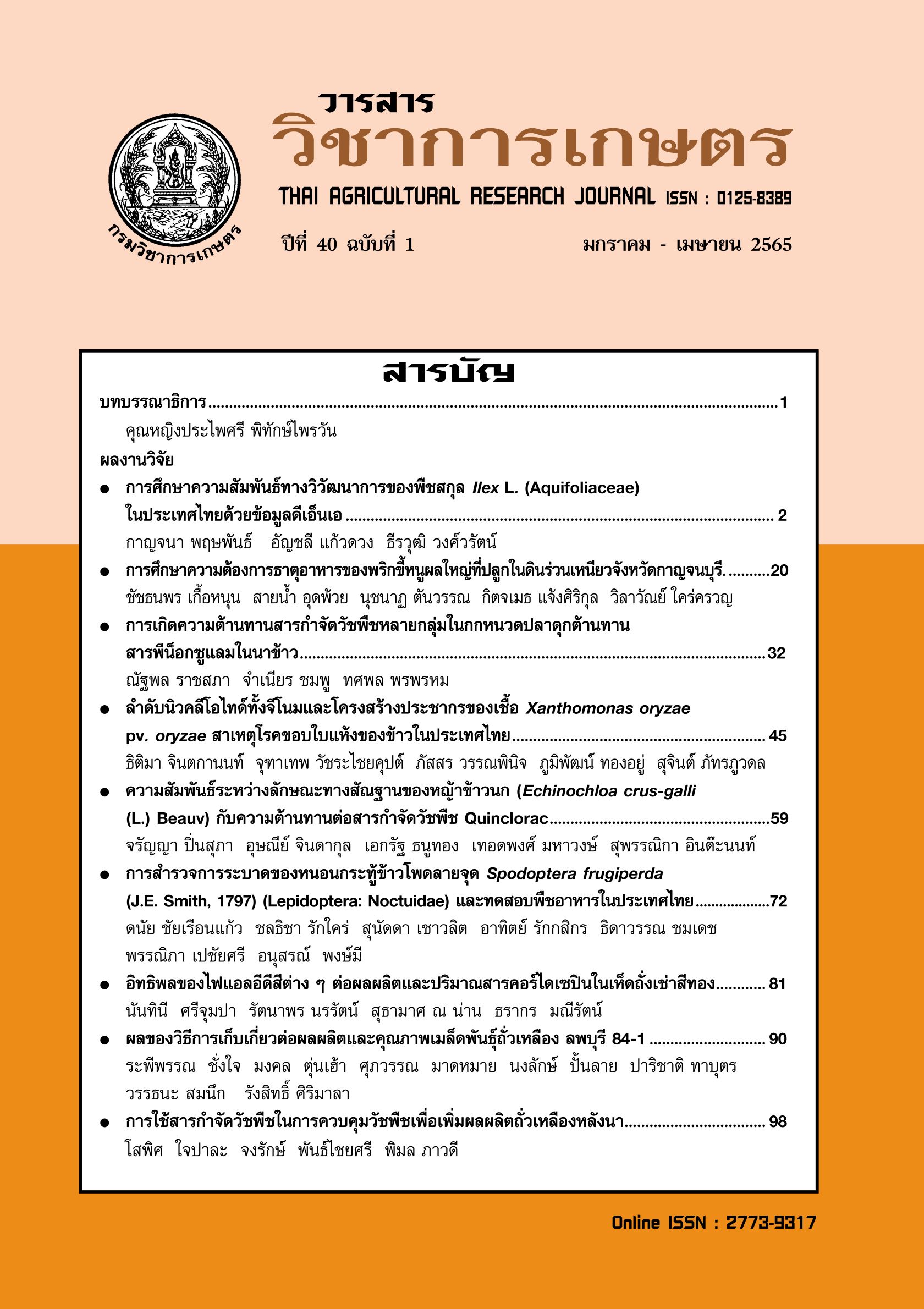พริก การศึกษาความต้องการธาตุอาหารของพริกขี้หนูผลใหญ่ที่ปลูกในดินร่วนเหนียว จังหวัดกาญจนบุรี
DOI:
https://doi.org/10.14456/thaidoa-agres.2022.2คำสำคัญ:
พริกขี้หนูผลใหญ่, ความต้องการธาตุ อาหาร, ปุ๋ยมูลวัว, ดินร่วนเหนียวบทคัดย่อ
การศึกษาความต้องการธาตุอาหารของพริก ขี้หนูผลใหญ่ที่ปลูกในดินร่วนเหนียว จ. กาญจนบุรี ระหว่างปีพ.ศ. 2560-2562 วางแผนการทดลอง แบบ 2x2x2+1 factorial in RCB 3 ซ้ำ ประกอบ ด้วย 3 ปัจจัย ดังนี้ ปัจจัยที่ 1 ปุ๋ยไนโตรเจน (N) 2ระดับ คืออัตรา10 และ20กก. N/ไร่ ปัจจัยที่2 ปุ๋ยฟอสเฟต(P)2ระดับ คืออัตรา5 และ10กก. P2 O5 /ไร่ และปัจจัยที่ 3 ปุ๋ยโพแทช (K) 2 ระดับ คือ อัตรา 12 และ 24 กก. K2 O/ไร่ และกรรมวิธีที่ไม่ใส่ปุ๋ยเคมี รวม 9 กรรมวิธีโดยทุกกรรมวิธี ใส่ปุ๋ยมูลวัว อัตรา 1,000 กก. น้ำหนักแห้ง/ไร่ ผลการทดลองพบว่าต้นพริก(ส่วนของลำต้น+ใบ) มีความเข้มข้นของธาตุอาหาร N มากที่สุดรองลง มาคือ K แคลเซียม(Ca) แมกนีเซียม (Mg) และ P ตามลำดับ และมีปริมาณลดลงตามระยะการ เจริญเติบโตที่เพิ่มขึ้น ยกเว้น Ca ซึ่งมีความเข้มข้น ของธาตุอาหารเพิ่มขึ้นตามระยะการเจริญเติบโตที่ เพิ่มมากขึ้น ขณะที่ปริมาณการดูดใช้ธาตุอาหารใน พริก(ลำต้น+ใบ+ผล) ในช่วงออกดอก-ช่วงพัฒนา ผล N และ K มีปริมาณไม่แตกต่างกัน แต่สูงกว่า Ca, P และ Mgโดยมีปริมาณการดูดใช้ธาตุอาหาร N, K, Ca, Mg และ P เท่ากับ 18.61, 13.51, 9.77, 2.93 และ 1.77 กก. N, K, Ca, Mg และ P/ไร่ ตามลำดับ เมื่อพิจารณาผลตอบแทนทาง เศรษฐกิจ พบว่า การผลิตพริกขี้หนูผลใหญ่ในดิน ร่วนเหนียว จ. กาญจนบุรีที่มีปริมาณอินทรียวัตถุ 2.0% ฟอสฟอรัสที่เป็นประโยชน์13 มก./กก. และโพแทสเซียมที่แลกเปลี่ยนได้ 115 มก./กก. แนะนำให้ใส่ผลตอบแทนในค่า VCR 24 และให้ผลผลิตสูงสุด
References
กรมวิชาการเกษตร. 2553. คำแนะนำการใช้ปุ๋ยกับพืชเศรษฐกิจ. กระทรวงเกษตรและสหกรณ์.122 หน้า.
รุ่งนภา โบวิเชียร. 2562. พริก. แหล่งข้อมูล http://www. agriman.doae.go.th สืบค้น: 22 กุมภาพันธ์ 2564.
ธรรมศักดิ์ ทองเกตุ และปิยะณัฏฐ์ ผกามาศ. 2561. การศึกษาอิทธิพลของธาตุอาหารพืชเพื่อการควบคุมความเผ็ดในพริก. แหล่งข้อมูล: https://dspace. tarr.arda.or.th/handle/6622815955/20587. สืบค้น: 23 พฤษภาคม 2562.
สมศักดิ์ ฉิมมา สายชล สุขญาณกิจ สิริวรรณ สมิทธิ อาภรณ์ และโสภิดา จิวประเสริฐ. 2563. การตอบสนองด้านการเจริญเติบโตและผลผลิต ของแตงกวาลูกผสมต่อปุ๋ยฟอสฟอรัส. Thai Journal of Science and Technology. 9(2): 276-286.
อรัญญา ลุนจันทา. 2553. ธาตุอาหารในใบพริก. น.ส.พ. กสิกร. 83(4): 50-57.
Amisnaipa, A., D. Susila, D. Nursyamsi and D.W. Purnomo. 2016. Determination of potassium (K) fertilizer requirement for pepper (Capsicum annuum L.) on Inceptisols soil. J. Agronomy. 15(4): 165-172.
AOAC. 1990. Official method of analysis of the association of official analytical chemists. Virginia, USA. 684 p.
Bar-Tal, A., B. Aloni, L. Karni, J. Oserovitz, A. Hazan, M. Itach, S. Gantz, A. Avidan, I. Posalski, N. Tratkovski and R. Rosenberg. 2001. Nitrogen nutrition of greenhouse pepper. I. Effects of nitrogen concentration and NO3 :NH4 ratio on yield, fruit shape and the incidence of blossom-end rot in relation to plant mineral composition. Hort. Sci. 36(7): 1244-1251.
Bremner, J.M. 1960. Determination of nitrogen in soil by the Kjeldahl method. J. Agri. Sci. 55:11–33.
Bray, R.H. and N. Kurtz. 1945. Determination of total, organic and available forms of phosphorus in soil. Soil Sci. 59:39-45.
Charlo, H.C. de O, S.F. de Oliveira, P.F. Vargas, R. Castoldi, J.C. Barbosa and L.T. Braz. 2012. Accumulation of nutrients in sweet peppers cultivated in coconut fiber. Hortic. Bras. 30: 125-131.
Chen, W-S and S. Uemoto. 1975. Studies on Calcium Absorption in Vegetable Crops. I. Studies on calcium absorption in vegetable crops: The absorption and physiological significance of calcium in vegetative and reproductive phases of plant growth. Japan. Soc. Hort. Sci. 45(1): 33-42.
Davis, L.E. 1943. Measurements of pH with the glass electrode as affected by soil moisture. Soil Sci. 56(6): 405-422.
Delahaut, K.A. and A.C. Newenhouse. 2011. Growing tomatoes, peppers, and egg plants in Wisconsin. Available at :https://hort. extention.wisc.edu. Accessed: September 30, 2021.
Guertal, E.A. 2000. Pre plant slow release nitrogen fertilizers produce similar bell pepper yields as split applications of soluble fertilizers. Agronom J. 92: 388-393.
Hamilton, H.A. and R. Bernier. 1975. N-P-K fertilizer effects on yield, composition and residues of lettuce, celery and carrot and onion grown on an organic soil in Quebec. Can. J. Plant Sci. 55: 453-461.
Hassan, S.A., J.M. Gerber and W.E. Splittstoesser. 1993. Growth and yield potential of green pepper as affected by nitrogen at transplanting. Pertanika J. Trop. Agric. Sci. 16(92): 101-105.
Hegde, D.M. 1997. Nutrient Requirements of Solanaceous Vegetable Crops. Food and Fertilizer Technology Center. Available at: https://www.agnet.org/library.php. Accessed: December 27, 2020.
Islam, Md. R., T. Sultana, Md. A. Haque, Md. I. Hossain, N. Sabrin and R. Islam. 2018. Growth and yield of chilli influenced by nitrogen and phosphorus. J. Agri. Veterinary Sci. (IOSR-JAVS). 11:54-68.
Mayorga-Gomez, A., S.U. Nambeesan, T. Coolong and J.C. Díaz-Perez. 2020. Temporal relationship between calcium and fruit growth and development in Bell Pepper (Capsicum annuumL.). Hort. Sci. 55(6):906–913.
Navarro, A.F., J. Cegarra, A. Roig and D. Garcia. 1993. Relationships between organic matter and carbon contents of organic waste. Bio-res. Tech. 44: 203-207.
Piper, C.S. 1966. Soil and plant analysis: A laboratory manual of methods for the examinationof soils and the determination of the inorganic constituents of plants. Bombay Hans Publisher. 368 p.
Pratt, P.F. 1965. Potassium.pp. 1022-1030. In C.A. Black, (ed.) Methods of Soil Analysis. Part II. Amer. Soc. of Agron, Inc. Madison, Wisconsin.
Richard, L.A. 1954. Diagnostic and Improvement of Saline Alkaline Soils. U.S. Salinity Laboratory, U.S. Dept. Agricultural Handbook No. 60. 160 p.
Saha, D., O.A. Fakir, S. Mondal and R.C. Ghosh. 2017. Effect of organic and inorganic fertilizerson tomato production in saline soil of Bangladesh. J. Sylhet Agril. Univ. 4(2): 213-220.
Santiago, C.L. and M.R. Goyal. 1985. Nutrient uptake and solute movement in drip irrigated summer peppers. J. Agri. U. Puerto Rico. 69 (1): 63-68.
Shil, N.C., H.M. Naser and S. Brahma. 2013. Response of chilli (Capsicum annuum L.) to zinc and boron application. Bangladesh J. Agril. Res. 38(1): 49-59.
Shobharani, P. and A. Latha. 2015. Effect of secondary and micronutrients on nutrient uptake and yield of rice in Kole Lands. Int. J. Curr. Res. 7: 22123-22126.
Simonne, E.H. and G.J. Hochmuth. 2010. Chapter II Soil and Fertilizer Management for Vegetable Production in Florida. In Olson, S.M. and S. Bielinski, (ed.) Vegetable Production Handbook for Florida. University of Florida IFAS Extention 2010-2011, USA.
Walkley, A. and I.A. Black. 1934. An examination of Degtjareff method for determining soil organic matter and a proposed modification of the chronic acid titration method. Soil Sci. 37: 29-38.
Yan, B.and Y. Hou.2018. Effect of Soil Magnesium on Plants: a Review. Earth and Environ mental Science2nd International Symposium on Resource Explorationand Environmental Science: Availableat:http://iopscience.iop. org . Accessed: July 24, 2021.
Downloads
เผยแพร่แล้ว
How to Cite
ฉบับ
บท
License
Copyright (c) 2021 วารสารวิชาการเกษตร

This work is licensed under a Creative Commons Attribution-NonCommercial-NoDerivatives 4.0 International License.
วารสารวิชาการเกษตร


